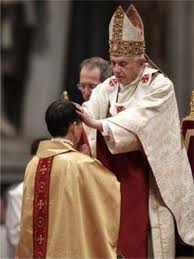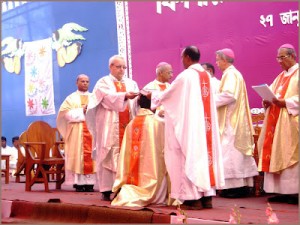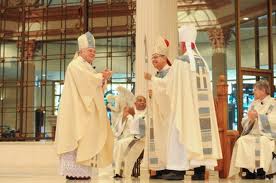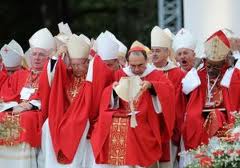“Sorry guys. I can no longer consider this rite invalid, at least not materially.
“The prayer of consecration itself, in its ENTIRETY clearly and univocally denotes the grace of the holy spirit, that this grace is the gift of the high priesthood, and that the rank of bishop is being conferred, with some of the particular powers of bishops mentioned: ‘Through the Spirit who gives the grace of high priesthood grant him the power to… assign ministries as you have decreed, and to loose every bond by the authority which you gave to your apostles.’
“This, for me is earth shattering. There is absolutely no doubt as to the intention here. I agree Paul VI shouldn’t have changed it, but I mean, LOOK. It clearly spells out the role of a Catholic Bishop.”
Now, I personally disagree with his estimation of the rite’s intention. I see nothing of the consecration coinciding with the true rite, describing the faculties of a bishop, (to judge, interpret, consecrate, ordain, offer sacrifice, baptize or confirm). Can you perhaps comment on his concerns? I fear for his soul, should he be lost to the SSPX or, worse still, the Modernists.
RESPONSE: This is a variant of an objection to my lengthy 2006 article on the 1968 Rite of Episcopal Consecration, “Absolutely Null and Utterly Void,” that I have answered before, but perhaps not in sufficient detail. I will try to remedy that here.
Your friend’s objection does not really concern intention (what the minister intends to do) but rather the sacramental form the minister pronounces: Does it say what it is required to say? And does it therefore “work”?
Assessing this objection hinges on the principle that Pius XII laid down in Sacramentum Ordinis: That the essential sacramental form for the conferral of the episcopacy must univocally signify its sacramental effects: (1) the power of the order being conferred (the Order of episcopacy) and (2) the grace of the Holy Ghost.
Your friend (and others) argue that, even though the short passage in the Prayer of Consecration that Paul VI designated as the essential sacramental form may not specifically mention the rank of the episcopacy, other language in the Prayer (high priest-hood, power to assign ministries, loose every bond) clearly and univocally denotes that the rank of bishop is being conferred.
The whole Prayer of Consecration, in other words, makes up for seeming any lack of clarity in the essential sacramental form about the power of the Order being conferred, i.e., the episcopacy.
So what of this objection? At first glance, it may seem like a plausible argument for validity. It does not, however, withstand closer scrutiny.
————————————
I. OVERTHROWING A GENERAL PRINCIPLEBy proposing the whole Prayer of Consecration as a requisite for properly understanding the essential form, this argument overthrows the distinction in sacramental moral theology between the words of the rite as a whole and the essential form, which strictly speaking includes “only those words without which the sense of the sacramental sign cannot exist,” and which are therefore re-quired for validity.
A substantial defect in an essential sacramental form. however, cannot be rendered valid by the language that surrounds it, no matter how specific it may be. Two examples will illustrate the point.
A. Penance. Thus, while the Roman Ritual II.2 designates four prayers (Misereatur, Indulgentiam, Dominus Noster, Passio Domini) as the “Common Form of Absolution,” only the last sentence of the third prayer is considered the essential sacramental form: I absolve you of your sins in the name of the Father, and of the Son, and of the Holy Ghost.
If one of the requisite elements is omitted from the latter formula (I, absolve, you or your sins), the language in the surrounding prayers (forgive you your sins, grant you absolution, remission of sins) does not supply for or fix the omission. The formula is invalid, period.
B. Baptism. Here too, the texts that precede and follow the es-sential sacramental form (I baptize you in the name of the Father, and of the Son, and of the Holy Ghost) contain language that refers to new birth, the bath where one is born anew, calling to the font of Baptism, cleansing and sanctification, the grace of baptism, the will to receive baptism, new birth by water and the Holy Ghost, remission of all sins, and safeguarding of one’s baptism by a blameless life.
However, if I recite all these prayers but omit the word “baptize’ or “you” when I pour the water, the baptism is invalid, because these words are essential elements of the form. It cannot signify without it. The context cannot remedy such omissions, and the rite is invalid, period.
————————————
II. A MISSING ELEMENT
Pius XII said that the essential form for Holy Orders must signify both the grace of the Holy Ghost and the order being conferred.
While the essential form Paul VI prescribed contains an ex-pression (spiritus principalis) that can be construed as (among eleven other things) the grace of the Holy Ghost, the new form does not contain a second expression that could be construed as the Order of episcopacy.
So even assuming that phrases elsewhere in the Prayer (high priesthood, power to assign ministries) clearly connoted the Order of episcopacy, the essential form itself lacks the requisite expression for the phrases to “clarify.” It simply isn’t there.
————————————
III. ADMISSION OF A SUBSTANTIAL DEFECT
Arguing that phrases elsewhere in the Prayer of Consecration must be adduced to clarify the essential sacramental form, moreover, is an admission that the latter is not univocal, and therefore defective.
Otherwise, why would one have to look elsewhere in the Prayer of Consecration to figure out what the essential form signifies?
————————————
IV. EQUIVOCAL QUALIFIERSWhat of the particular expressions themselves? The sentence following the new form speaks (in a subordinate clause) of one “whom You [God] have chosen for the episcopate,” adding:
May he be a shepherd to your holy flock, and a high priest blameless in your sight, ministering to you night and day; may he always gain the blessing of your favor and offer the gifts of your holy Church. Through the Spirit who gives the grace of high priesthood grant him the power to forgive sins as you have commanded, to assign ministries as you have decreed, and to loose every bond by the authority which you gave to your apostles.
So even assuming for the sake of argument that another element is present in the Paul VI form to construe as the power of the Sacred Order of bishop, would the foregoing language indeed render that element univocal?
A. High Priesthood. The two expressions referring to high priesthood may at first look helpful to the argument for validity, but they do not in fact unequivocally connote the Sacred Order of bishop.
The reason is that Eastern Rite liturgies use similar language in non-sacramental rites to “consecrate” a Metropolitan or a Patriarch. These prayers ask that the candidate serve according to the order of the Great Highpriest, that he is chosen as a high priest over all Thy Church, be a faithful high priest over thy housE, he function in the high priesthood, etc.
But they do so for offices that are jurisdictional, not sacramental. So the expressions in the Paul VI Prayer of Consecration cannot be univocal, because they can be used to confer a non-sacramental office as well.
B. Enumerated Powers. Nor do the powers of the high priest-hood enumerated after the new sacramental form unequivocally signify the Sacred Order of bishop.
• To forgive sins. This is a sacramental power that a priest also possesses.
• Assign ministries (or distribute “offices” or “gifts”). These acts do not depend upon the sacramental powers of a bishop but upon someone receiving ordinary jurisdiction. Again, a simple priest who received ordinary jurisdiction could “assign ministries.”
• Loose every bond. This, too, has nothing to do with sacramental powers, and depends only upon jurisdiction.
————————————
V. SIGNIFICANT OMISSIONS
Moreover, the non-episcopal powers enumerated in the Paul VI Prayer of Consecration and mentioned above in IV.B actually strengthen the case against validity. Why? Because of what they replace and omit.
The source given for the Paul VI Prayer of Consecration was the Apostolic Tradition of Hippolytus. Various reconstructions of this work, however, contain a petition to God that the candidate would receive “the power… to confer orders according to your bidding” — a sacramental act proper to the Sacred Order of bishop.
In the Paul VI Prayer this has been replaced with assigning ministries or offices — a purely jurisdictional act.
That the omission was deliberate is clear from the Coptic Rite form for episcopal consecration, which Dom Botte, the principal author of the new rite, consulted to reconstruct the text of Hippolytus. The Coptic form further specifies after the phrase quoted above (to confer orders) that the bishop is to provide clergy “for the priesthood… to make new houses of prayer, and to consecrate altars.”
None of this appears in the Paul VI Prayer of Consecration.
————————————
Finally, the rubrics for the Prayer of Consecration in the new rite prescribe that co-consecrating bishops recite only the essential form. The balance of the prayer, which contains the phrases referring to high priesthood, etc., is recited by the principal consecrating bishop alone.
To argue that the latter language is needed to “clarify” the form is to imply that the co-consecrating bishops omitted something necessary to the validity of the rite. (= The words they recited were not truly univocal.)
* * *
THE “CONTEXT” argument cannot therefore be used to maintain that the Paul VI form for episcopal consecration is valid. It overthrows a general principle of sacramental moral theology, it posits the existence of an expression in the sacramental form that is not in fact present (one connoting the power of Orders), it implicitly admits an essential defect, it is founded on expressions that are themselves equivocal, and it is undermined by omission of elements that in the Apostolic Tradition and the Coptic rite referred unequivocally to powers proper the Sacred Order of bishop. The rubrics of the new rite itself, moreover, reduce the context argument to absurdity.
If one could regard the Paul VI Rite of Episcopal Consecration as unquestionably valid according to the principles of traditional Catholic sacramental moral theology, untold problems could be avoided.
But alas, it was not to be. The men who gave us the new rite also adhered to a new theology — and Catholics everywhere paid the price.
(Internet, March 2012)




4 Trackbacks/Pingbacks
[…] Saved by Context? The '68 Rite of Episcopal Consecration. (Reply to a 2012 objection) […]
[…] Guardado por contexto? El ’68 Rito de la Consagración Episcopal por el Padre. Anthony CekadaDúplica a la objeción popular de que el contexto más amplio proporcionado por el rito de 1968 de la ordenación de los obispos da una expresión clara de la forma sacramental y por lo tanto es suficiente para la validez. […]
[…] Guardado por contexto? El ’68 Rito de la Consagración Episcopal por el Padre. Anthony Cekada Dúplica a la objeción popular de que el contexto más amplio proporcionado por el rito de 1968 de la ordenación de los obispos da una expresión clara de la forma sacramental y por lo tanto es suficiente para la validez. […]
[…] Saved by Context? The ’68 Rite of Episcopal Consecration [March 2012] Rejoinder to the popular objection that the larger context provided by the 1968 rite of bishops’ ordination gives clear expression to the sacramental form and hence suffices for validity. […]